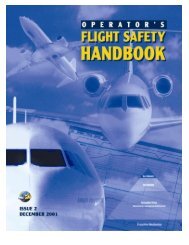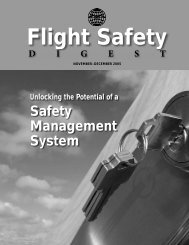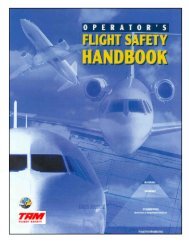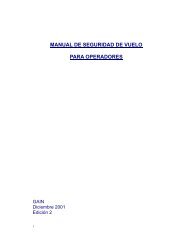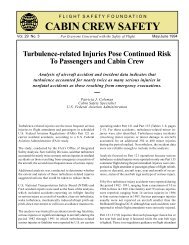Download PDF [10.9 MB] - Flight Safety Foundation
Download PDF [10.9 MB] - Flight Safety Foundation
Download PDF [10.9 MB] - Flight Safety Foundation
You also want an ePaper? Increase the reach of your titles
YUMPU automatically turns print PDFs into web optimized ePapers that Google loves.
COVERSTORY<br />
Selections From a 10-7 Issued for a Runway<br />
• The runway is not grooved and standing water is likely to be<br />
present when raining.<br />
• Braking action is likely to be fair–poor when the runway is wet.<br />
• Select and use the maximum autobrake setting.<br />
• Make every attempt to touch down at the 1,000-ft point.<br />
• Use maximum reverse thrust.<br />
16 | FLIGHT SAFETY FOUNDATION | AEROSAFETYWORLD | MAY 2013<br />
—JV<br />
rather than issuing generalized notifications and<br />
procedures, proper use of technology and cooperation<br />
by pilots can enable a clinical approach<br />
and more detailed procedures, better balancing<br />
safety with economic considerations.<br />
<strong>Safety</strong> Culture and Environment<br />
Continental Airlines had a long history of using<br />
flight/FOQA data to proactively enhance<br />
safety and efficiency, which has continued<br />
after the merger with United. Although the<br />
braking action test program and the initial<br />
10-7 FOQA alert may seem ordinary, the<br />
process epitomized what is needed to build a<br />
platform of understanding, trust and cooperation<br />
to create the right culture and environment<br />
for working with sensitive information<br />
such as FOQA data.<br />
For all parties in this test project, the focus<br />
has always been on safety. Nevertheless, it has<br />
been important to safeguard the corporate safety<br />
culture and environment by having proper<br />
systems, routines and procedures. When<br />
this test program surfaced, the operational<br />
management took a keen interest, provided<br />
the “green light,” and then supported the test<br />
program. This was important and provided the<br />
proper framework for the project’s more active<br />
participants.<br />
ALPA and the FOQA groups have had a<br />
long relationship and developed good rapport<br />
through many years of cooperation. The<br />
intriguing part was to have a third party working<br />
within the traditional format of the FOQA<br />
group and ALPA. It has been a success.<br />
The Future<br />
Although there has been an increasing focus<br />
on rain and wet runways, the braking action<br />
test program was not specifically set up to<br />
find runways prone to higher risk in rain. It<br />
was part of a general move to better and more<br />
accurately assess the braking capability of aircraft,<br />
in particular during challenging winter<br />
conditions.<br />
The on-board system developed is now<br />
downloaded onto all United’s Boeing 737NGs,<br />
representing a significant network. Today,<br />
this aircraft network furnishes braking action<br />
information daily, albeit not yet for operational<br />
purposes but only for FOQA group analysis.<br />
United’s pilots will continue to serve a<br />
pivotal role in the system verification by<br />
providing valuable feedback. A print function<br />
has been programmed on the flight deck and<br />
activated for response, thereby simplifying<br />
participation by pilots. The test program will<br />
continue to be focused on runway conditions<br />
where braking action is assessed to be less<br />
than good by the numerical scale of airplane<br />
braking coefficient.<br />
In terms of the future viability of the system,<br />
the algorithm and program have proved<br />
stable and reliable. Currently the system is undergoing<br />
a validation in cooperation with the<br />
U.S. Federal Aviation Administration. Access<br />
to and availability of FOQA data provide new<br />
opportunities to improve safety and efficiency<br />
of airline operations. By the same token, it is<br />
important that the necessary framework be in<br />
place to pursue desired results, such as those<br />
that have been evident in this project.<br />
Joe Vizzoni has been a part of this test program and all the<br />
processes described from its start. He is a first officer with<br />
United Airlines on the Boeing 757 and 767 and also has<br />
experience as an aerospace engineer, of which nine of 14<br />
years were with Boeing.<br />
Note<br />
1. Thrust reversers are most efficient at higher speed, so<br />
to reduce the kinetic energy of a landing aircraft, it<br />
is best to apply them at once, thus carrying forward<br />
less energy toward the end of the runway.


![Download PDF [10.9 MB] - Flight Safety Foundation](https://img.yumpu.com/18550968/18/500x640/download-pdf-109-mb-flight-safety-foundation.jpg)

![Download this Issue [PDF 7 MB] - Flight Safety Foundation](https://img.yumpu.com/18859635/1/190x245/download-this-issue-pdf-7-mb-flight-safety-foundation.jpg?quality=85)
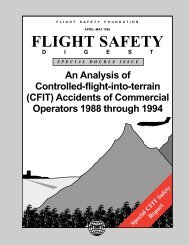
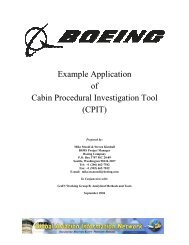
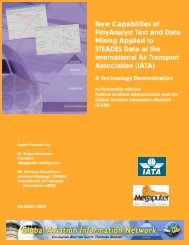
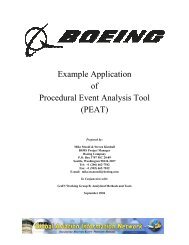
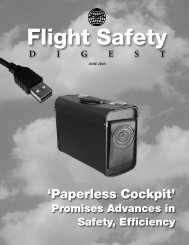
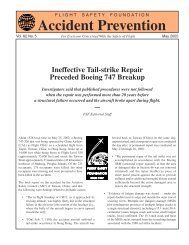
![Download [PDF 8 MB] - Flight Safety Foundation](https://img.yumpu.com/18859366/1/190x245/download-pdf-8-mb-flight-safety-foundation.jpg?quality=85)
